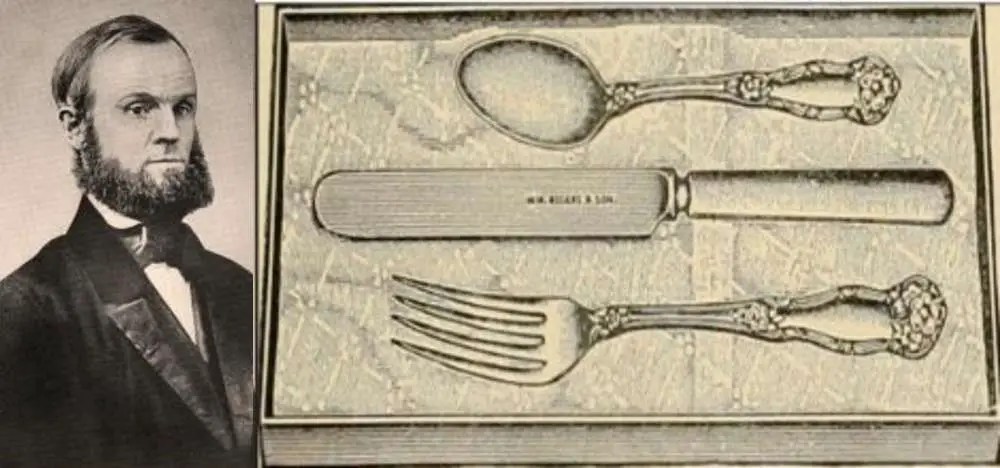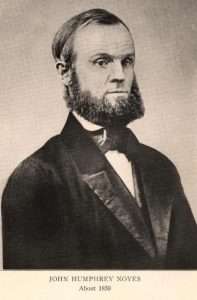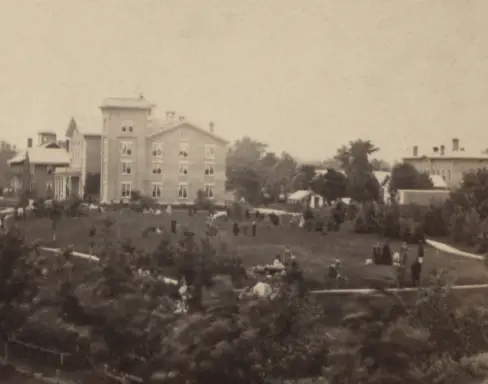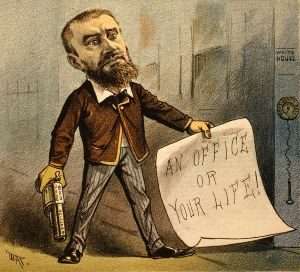John Humphrey Noyes started out in the 19th century as a conventional Yale-trained minister until he found out he was perfect and without sin.
He attracted hundreds of followers who liked thinking they were perfect, too. They followed John Humphrey Noyes to his utopian communities in Putney, Vt., Wallingford, Conn., and Oneida, N.Y.
There they prospered. But John Humphrey Noyes liked sex as much as he liked being perfect, and he wound up fleeing to Canada.
He left a legacy, though, on millions of dining room tables throughout the world.
John Humphrey Noyes
He was born in Brattleboro, Vt., on Sept. 3, 1811, with a silver spoon in his mouth. His father, John Noyes, went to Congress, and his mother, Polly Hayes Noyes had a nephew who became president of the Unite States, Rutherford B. Hayes.
John Humphrey Noyes’ well-to-do family sent him to Dartmouth and then to Yale Theological Seminary.
In his second year in seminary, he decided Christ had already come a second time in 70 A.D. He then had a religious conversion, his second, after which he proclaimed he did not sin. His friends, unsurprisingly, began to think him unbalanced.
He converted a woman named Harriet Holton to his doctrine of Perfectionism, and they married in 1838. During the first six years of marriage she gave birth five times, but only one of their children lived. The couple then began living apart. He said the separation brought them both satisfaction that they had never before experienced.
Utopian Living
John Humphrey Noyes attracted about 40 followers of his Perfectionism, mostly New England farmers. After Yale kicked him out of school, Noyes and his followers moved to Putney, Vt.
In the mid-1840s, the Putney community began to experiment with communal living.
They shared some traits with the Shakers. For example, they believed in working for the good of the community, not just for oneself. And the whole community raised their children.
Unlike the Shakers, who didn’t have sex, the Perfectionists believed in having sex with multiple partners.
They didn’t hide their beliefs, which horrified Vermonters. A mob drove them out of Putney even as the state attorney general issued arrest warrants for John Humphrey Noyes on the grounds of adultery.
The Perfectionists moved to Oneida, N.Y., where they took out a mortgage for $2,000 on 40 acres of land, an old house, an abandoned Indian hut and an old Indian saw mill.
Silverware and Hats
They started out poor, sleeping on the floor of the old house. But they worked hard, sawing lumber for neighbors, raising crops and small fruit and making rustic furniture, silk thread, traps and palm frond hats. John Humphrey Noyes took up blacksmithing. Eventually the Oneidans starting making their famous silverware.
The community benefited from its remoteness and its simple living. It was so far from population centers that its young men didn’t have to register for the draft during the Civil War. And they used so few consumer goods they reinvested their profit in their business ventures.
The Perfectionists set up a satellite community in Wallingford, Conn., where they made matchboxes, and in Brooklyn, N.Y., where they made traveling bags. Two other small offshoots started in Newark, N.J., and Cambridge, Vt. After about a decade of hard work, they had accumulated a net worth of $67,000.
By 1875, they were worth $180,580 with about 300 members.
Criticism Prevents Novel Reading
They created a unique form of government called ‘criticism.’ It cured all sorts of faults, including selfishness, idleness, rudeness and a love of novel-reading.
In 1875 a New York journalist named Charles Nordhoff visited the Oneida community and watched a session of criticism. John Humphrey Noyes sat in a large rocking chair as a group of 15 criticized a young man named Charles, who sat in the middle of the room.
Charles, they told him, sometimes used slang, acted supercilious and haughty and sometimes used pet names for people he liked. One critic said Charles had condemned the beefsteak as tough and made other unnecessary remarks about the food on the table.
Charles himself conceded he had started to think religion wasn’t important, but he was correcting that error.
Criticism, apparently, didn’t work too well on one member of the community. Charles Guiteau lived in Oneida for five years before going off to assassinate President James Garfield.
Stirpiculture
But it was John Humphrey Noyes’ views on sex that got him into trouble. He believed in ‘complex marriage,’ or what others call polygamy.
He also believed people should create children intentionally rather than through haphazard sex. But John Humphrey Noyes believed the Christian view of sex — limited to marriage — had the effect of sexually starving young people from about age 14 until they wed.
He solved the problem by having young men practice having sex with older Perfectionist women who’d gone through menopause. That way, the young men could practice delaying gratification, which was Noyes’ preferred method of birth control. He also believed women had the right to choose whether to have a child.
John Humphrey Noyes reserved most of the community’s young virgins for himself.
Another odd practice: Men asked women to have sex through a third party. At least that cushioned the letdown.
By 1869, John Humphrey Noyes began encouraging the best and brightest young people to have children. He called it ‘stirpiculture’; others called it eugenics. That’s when the community began to have trouble, because parents wanted to raise their own children.
Families also began to raise their children for a competitive, capitalist society rather than for the communal good.
Trouble
Noyes also ran afoul of Anthony Comstock, a young New York reformer who founded the New York Society for the Suppression of Vice.
In 1879, John Humphrey Noyes heard a rumor that he was to be arrested for breaking the state’s marriage laws, so he fled to Canada. He died there on April 13, 1886.
The Oneida community went on to form a corporation. The business leaders determined the new company’s most profitable products were plated spoons. Eventually, the Oneida company grew into the world’s largest producer of flatware.
This story was updated in 2022.




1 comment
[…] Após o colapso do comércio de peles, os One Perfectionists continuaram a serralheria com uma linha de talheres. Em 1881, o culto entrou em colapso, mas a empresa de talheres sobreviveu. Hoje, Oneida Silverware é um dos pilares dos armários de porcelana em todos os lugares.(7) […]
Comments are closed.